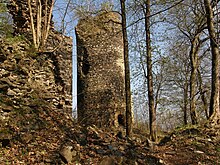Rýzmburk Castle
The castle ruins Rýzmburk , also Risemburg or Hrad Osek (German: Riesenburg ), stand on a steep slope of the Ore Mountains above the district of Hrad Osek in the city of Osek (German: Ossegg ) in the Czech Republic . The complex, which is very large for a castle (200 meters long and 95 meters wide) is now a freely accessible ruin with towers, passages and remains of walls.
history
The construction of the castle was completed in 1250 by the court marshal of Wenceslas I , Boresch von Riesenburg , who also called himself Bohuslav II and as the first of the Hrabischitz family "von Riesenburg", after ten years of construction. The family ruled most of northern Bohemia at the time . They owned the area of Bilin and Ossegg , which they were allowed to bequeath to the Bohemian princely family, the Přemyslids , thanks to their devotion . In addition to the castles in Ossegg and Bilin, they also owned the Hněvín Castle in Brüx and the legendary Hrabischin Castle on the site of today's castle in Dux .
Before 1323 there were serious changes. In a letter from the same year, Johann von Luxemburg confirmed to the Ossegg monastery that its assets and rights would be preserved. This means that at that time the castle was no longer in the hands of the giant burgers, but a royal fiefdom . At the end of the 14th century the power of the Hrabischitzer fell. In 1358 they finally sold the giant castle to the Margrave of Meissen , whose power grew more and more during this time. It was not until 1459 that the Bohemian King George of Podebrady received the castle back from Cheb due to the border treaty .
In the following years Zajíc von Hasenburg , the knights of Naptitz (z Naptic) and the lords of Rabenstein (z Rabštejna) lived in the castle. Their knights used it as a residence for their raids for a while. The lords of Sulewicz lived in the fortress from 1437 , but at the beginning of the 15th century they moved to their new seat, the Duxer Feste.
The castle fell into disrepair and it was not until the Romantic era , at the beginning of the 19th century, that the owners at that time, the Waldstein family , began to renovate and partially rebuild the former castle. They removed crumbling walls from inside the building and leveled the terrain. The old dungeon they built to a lookout tower. The castle walls were re-fortified.
After the founding of Czechoslovakia , the Czech Tourist Club (KČT), financed from private funds, took care of the building. However, he was only able to keep the most important entrances. The castle continued to deteriorate in the 20th century. When the castle came into the hands of the Czechoslovak Forestry Companies, there was no more money at all. It was only after the Velvet Revolution that the district committee of the Czech Nature Conservation Association initiated an extensive reconstruction of the castle with the participation of the state monument protection, including the work of volunteers.
tourism
A walking path (marked red) of the mountain Osek Stropník ( Strobnitz ) performs at Vorwerk north of the castle over, from which a circular path branches off down to the chapel below the castle.
literature
- Viktor Karell : Castles and palaces of the Ore Mountains and Egertal. Vol. 1, Vinzenz Uhl Verlagbuchhandlung, Kaaden , 1935 ("Die Riesenburg bei Osseg", pp. 78–79)
Web links
Coordinates: 50 ° 38 '2 " N , 13 ° 39' 53" E


